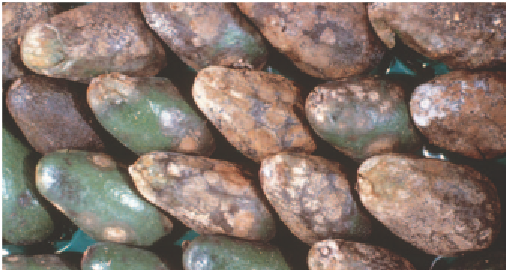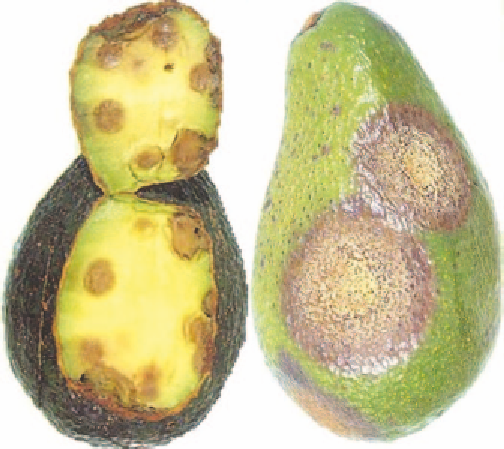Agriculture Reference
In-Depth Information
Fig 4.5 Cut fruit showing anthracnose lesions.
Anthracnose spots are not clearly visible against the black
skin of Hass.
In immature fruit still on the tree, large spreading spots,
similar to those that occur in ripe fruit, often develop
around insect or mechanical wounds. Fruit with these
spots are usually shed before harvest. In addition to these
large spreading spots, small spots less than 5 mm in
diameter may develop around fruit lenticels. Leaf spots
may also develop under very humid conditions.
Fig 4.2 Anthracnose in avocado. External symptoms on a green-
skinned variety and internal symptoms in the Hass variety.
Source of infection and spread
Large numbers of spores of the fungus are produced on
dead twigs, leaves and fruit. These spread through the
orchard during warm, showery weather, overhead irrigation
and heavy dews. Spores are deposited on the fruit surface
where penetration occurs. Fruit is susceptible to infection
from set to harvest. Typically, the fungus penetrates the peel
where it stops growing and remains dormant until the fruit
ripens. It then resumes active growth and invades the
surrounding tissues. In insect-damaged fruit on the tree,
the fungus may penetrate through peel wounds and cause
symptoms soon after.
Fig 4.3 Internal symptoms of anthracnose in Hass avocado showing
healthy and diseased peel.
Importance
Anthracnose is serious in wetter growing areas, particularly
in more susceptible cultivars. It is the major postharvest
disease of avocado.
Management
Field
•
Provide appropriate nutrition. High nitrogen and low
calcium levels in fruit exacerbate postharvest disease
development.
Spray with recommended fungicides from fruit set to
harvest.
•
Fig 4.4 Severe anthracnose in the market place.














